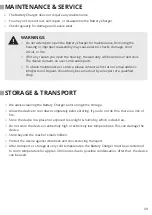
48
Burst & Explosion Hazards
Burst hazard.
Do not use the unit for charging dry-cell batteries that are commonly used with
home appliances. These batteries may burst and cause injury to persons and
damage property. Use the unit for charging a lead-acid battery only.
WARNING:
WARNING:
Explosion hazards
●
Do not smoke, strike a match or use a lighter, or create a spark near the battery.
●
Working in the vicinity of a lead-acid battery is dangerous. Protect yourself from
a highly explosive hydrogen-oxygen reaction! The battery may emit gaseous
hydrogen during charging. Oxyhydrogen is an explosive mix of gaseous hydrogen
and oxygen. Contact with open fire (flames, embers, or sparks) will cause the so-
called oxyhydrogen reaction!
●
Perform charging in a well-ventilated room. Be sure there is no open fire during
charging! To reduce the risk of battery explosion, follow these instructions and
those published by the battery manufacturer and manufacturer of any equipment
you intend to use in the vicinity of the battery.
●
Ensure the positive terminal connection cable does not come into contact withfuel
lines (e.g. petrol pipe)!
●
Put the power off before cleaning. Never clean while charging a car battery.
●
A soft dry cloth is recommended for cleaning the exterior of the Battery Charger.
●
Be careful not to put too much pressure on the display or buttons while cleaning.
●
Do not immerse the Battery Charger in water or any other liquids. It is not allowed to rinse
the device with water, to prevent the water from leaking into the electrical circuit and causing
malfunctions.
●
Under no circumstances use aggressive cleaning agents, cleaning alcohol, or other chemical
solutions since these can penetrate the housing or impair functionality.
●
Do not use a wire brush, steel wool, or other abrasive objects for cleaning.
●
Cleaning must not be performed by children.
CLEANING





































